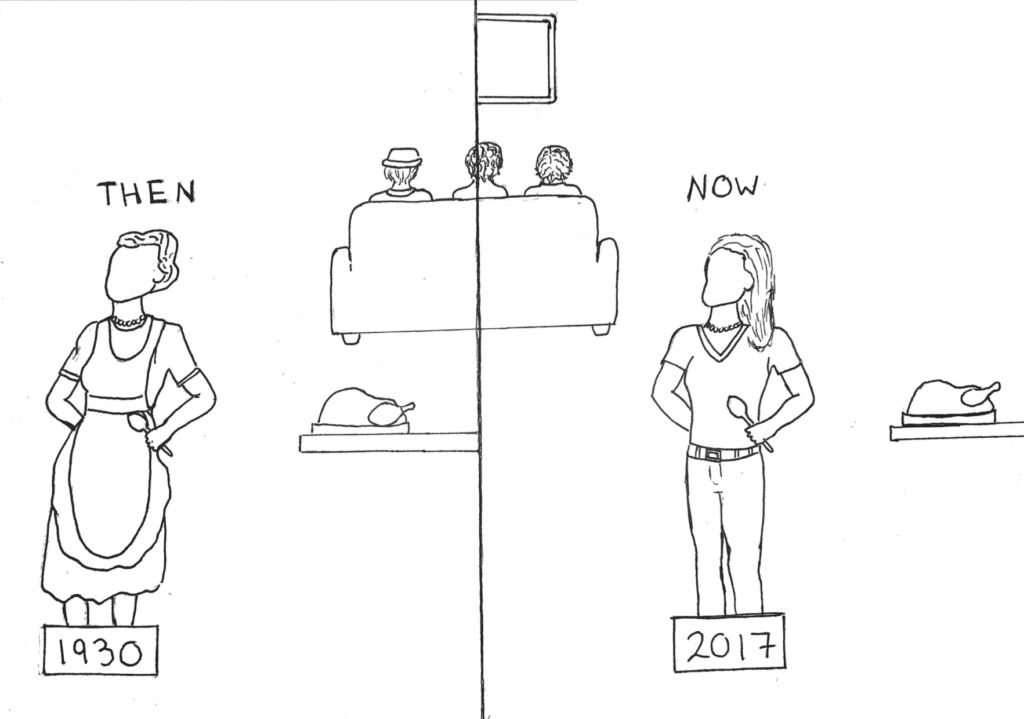
My aunt bustled frantically around the kitchen, as more family members trickled into her home. The pots and pans clattered as the conversations grew louder to drown out the noise. This was yet another normal Thanksgiving until I noticed one caveat—the only people cooking and cleaning were women.
This revelation would not be so shocking if I was part of an overtly sexist family. But I’m not; contributions in my family are not dependent on gender. It seems like a sexist structure that only women do the cooking and cleaning around the holidays in my family. While their work doesn’t go unnoticed, it is single-handedly the work of women. But why, if the members of my family harbor no ill-will towards women, is this a continuing trend?
Not once have I drawn a parallel between gender norms and my family Thanksgiving, but this holiday, I was forced to question if our rituals are dragging us back to the patriarchal times we used to live in. In women’s fight for equality, we have made considerable advancements compared to a century ago. Women’s roles in society have rightfully extended beyond the household. However, about 50 percent of adults believe that the United States has not gone far enough in giving equal rights to women, according to Pew Research Center. Today, it is evident that outward sexism and obvious gender roles still exist.
And in my family, for one evening every year during the holidays, the traditional gender norms we have fought to break emerge. Yet, no one seems to notice. It isn’t like this the rest of the year—the males usually help in meal preparations and doing the dishes—but they don’t help on Thanksgiving and other holidays.
I would never have noticed the connection between these traditions and these standards had my whole family not been sitting on the couch when someone turned to me and my sister said, ‘Girls, go help.’ To which I replied, ‘Why don’t any of the guys get up and help?’ Nobody answered my question, because nobody had a legitimate answer or even realized what was going on. Women preparing the holiday meal is simply standard.
I can, with confidence, attribute this dismal reality to a simple lack of awareness. Because the men generally help out more often throughout the year, having just the females prepare the entirety of the meal is not unusual. Nobody pays attention to how the holiday meal is made, as long as it makes it to the table. My family didn’t notice that no man hopped up to help cook or clean because this was just the way it had always been. These gender roles don’t appear inherently wrong because they have been part of the holidays for as long as I can remember. No female in my family spoke up about the workload or the lack of help because they never have. And frankly, I don’t see any of them doing so any time soon. While it may be easy to blame the men for this rut we are stuck in, it seems to me as though the women are just as oblivious.
My Thanksgiving was just how I imagined it would be in the 1930s. There was a stereotypical housewife standing in the kitchen with her apron and wood spoon while the men smoked cigars, lounging around and conversing amongst themselves. It sounds extremely cliché, but this is exactly what I observed. Despite all the strides women have made, we were stuck in a modern-day nightmare.
I understand that this unintentional recession to outdated gender norms could be perceived as just another holiday, just another meal. The fact that the only people in the kitchen were women may have been unintended, but there lies the issue. The holiday itself is driving us towards those traditional duties we are ‘supposed’ to perform.
I can’t speak for everyone, but you might notice it in your own families, too. The sexism in our holiday traditions is not always obvious, but could be as simple as who sets the table or who cleans the dishes.
As a whole, we are rapidly developing our ideals and changing our views of the world. I should hope that as the world advances and females continue working for equality, our holiday traditions will follow suit.






